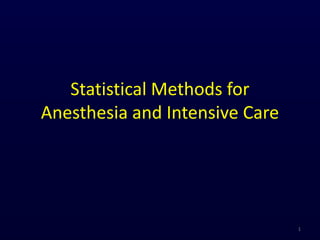
Chapter 1 usagpan statistics
- 1. Statistical Methods for Anesthesia and Intensive Care 1
- 2. Required Materials/Resources 2 Selected Youtube Videos Primary Supplement to facilitate understanding
- 3. Exams • Chapters 1-4 • Chapters 5-9 • Chapters 10-13 • Comprehensive Final 3
- 4. Type of Data Qualitative (Categorical) Type of Categorization One categorical variable Goodness of fit X2 Two categorical variables Contingency Table X2 Quantitative (Continous) Type of Question Relationships Number of Predictors One Measurement Continuous Primary Interest Degree of Relationship Pearson Correlation Form of Relationship Regression Ranks Spearman's’ r Multiple Multiple Regression Differences Number of Groups Two Relation between Samples Independent Two Sample t Mann-Whitney Dependent Related Sample t (paired t tests) Wilcoxon Multiple Relation between Samples Independent Number of Independent Variables One One Way ANOVAs Kruskal-Wallis Multiple Factorial ANOVAs Multivariate Analysis Dependent Repeated Measures Friedman
- 5. Chapter 1 – Data Types 5
- 6. Types of Data • Key Points – Categorical data - nominal and can be counted. – Numerical data may be ordinal, discrete, or continuous, and are usually measured. – VAS measurements are ordinal data. 6
- 7. Types of Data • Qualitative – Data which is descriptive and characterizes an event and may include an intangible measure of worth or quality. 7
- 8. Types of Data • Quantitative – Data which is measured via a numerical scale. 8
- 10. Categorical Data • Observations are grouped in categories, counted, and sorted accordingly. • When there are only two categories or choices the data is referred to as binary or dichotomous. 10
- 11. Categorical Data • Examples – Gender • Male • Female – Type of operation • CABG • Hysterectomy • Cholecystectomy • Appendectomy 11
- 12. Categorical Data • Examples – Type of ICU Admission • Medical • Surgical • Injury • Illness – Adverse/Untoward Event • NPPE • Positioning nerve injury • Transfusion reaction • PONV 12
- 13. Categorical Data • Reporting – Absolute count – Percentages – Rates – Proportions 13
- 14. Ordinal Data • Data in which a relative value or ranking can be applied. – Can be viewed as a hybrid between categorical and numerical data. – The true measure of the data is not tangible but it does have an essence that is more than just descriptive. 14
- 15. Ordinal Data • Recording observations – Typical some type of numerical system is applied. • Numbers • Roman numerals – Scoring can also be letters or symbols • A, B, C, D • +, ++, +++, ++++ • The advantage of a numerical system – Data can undergo nonparametric statistical analysis. • In a nutshell, using a parametric statistical analysis on ordinal data. 15
- 16. Numerical Data • Quantitative Data – Discrete measurments – Continuous measurements • Discrete data – Can only be a whole integer • You cannot have half a person • Continuous data – Can take any value • CBC values • Cardiac Index 16
- 17. Numerical Data • There can be further division of Continuous Data. – Interval data – Ratio data 17
- 18. Numerical Data • Interval Data – Location of the zero value is arbitrary and not a true zero point. • Celsius temperature, Dates • Ratio Data – Simply stated this data has a true zero reference point. • Kg, m, in., lb, Kelvin temperature 18
- 19. Numerical Data • Reporting Numerical Data – Mean – Standard deviation – Median – Range 19
- 20. A frequent tool used in Anesthesia • VAS – Can measure, pain, PONV, anxiety, patient satisfaction. – When using the 100 mm scale some researchers use erroneously this data as continuous data. • Is everyone’s pain the same? 20
- 21. Ranking of Data Types Ratio Interval Ordinal Nominal 21
- 22. Ranking of Data Types 22
- 23. Changing Data Scales • Smoking status can be recorded as smoker/non-smoker (categorical data), heavy smoker/light smoker/ex-smoker/non-smoker (ordinal data), or by the number of cigarettes smoked per day (discrete data). • MI – ischemia or no ischemia, or the extent of ST segment depression in mm. 23
- 24. Questions on Chapter 1? 24